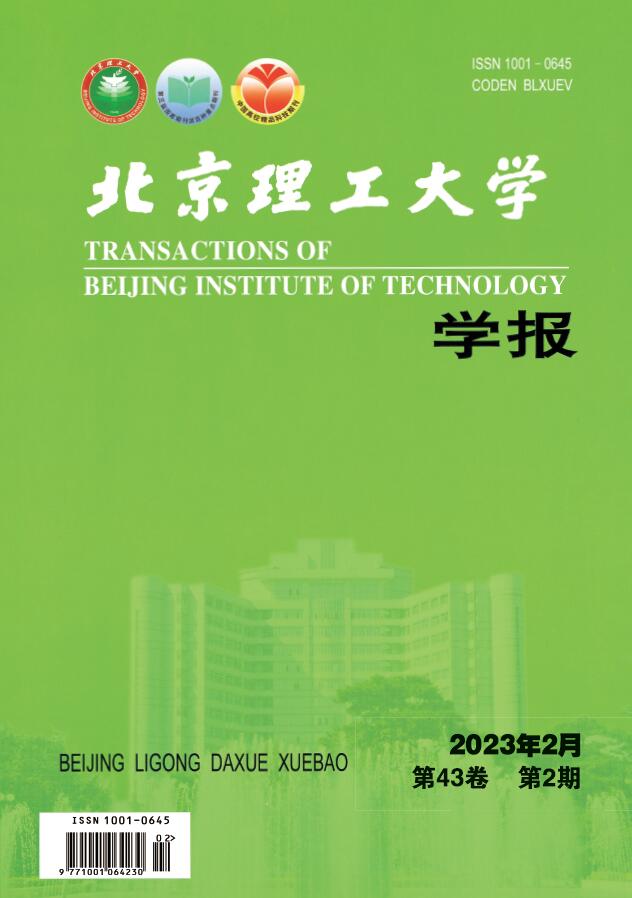2018 Vol. 38, No. S1
Display Method:
2018, 38(S1): 1-4.
doi:10.15918/j.tbit1001-0645.2018.增刊1.001
Abstract:
2018, 38(S1): 5-9.
doi:10.15918/j.tbit1001-0645.2018.增刊1.002
Abstract:
2018, 38(S1): 10-14.
doi:10.15918/j.tbit1001-0645.2018.增刊1.003
Abstract:
2018, 38(S1): 15-19.
doi:10.15918/j.tbit1001-0645.2018.增刊1.004
Abstract:
2018, 38(S1): 20-23.
doi:10.15918/j.tbit1001-0645.2018.增刊1.005
Abstract:
2018, 38(S1): 24-28.
doi:10.15918/j.tbit1001-0645.2018.增刊1.006
Abstract:
2018, 38(S1): 29-32.
doi:10.15918/j.tbit1001-0645.2018.增刊1.007
Abstract:
2018, 38(S1): 33-37.
doi:10.15918/j.tbit1001-0645.2018.增刊1.008
Abstract:
2018, 38(S1): 38-43.
doi:10.15918/j.tbit1001-0645.2018.增刊1.009
Abstract:
2018, 38(S1): 44-48.
doi:10.15918/j.tbit1001-0645.2018.增刊1.010
Abstract:
2018, 38(S1): 49-54.
doi:10.15918/j.tbit1001-0645.2018.增刊1.011
Abstract:
2018, 38(S1): 55-58.
doi:10.15918/j.tbit1001-0645.2018.增刊1.012
Abstract:
2018, 38(S1): 59-62.
doi:10.15918/j.tbit1001-0645.2018.增刊1.013
Abstract:
2018, 38(S1): 63-66.
doi:10.15918/j.tbit1001-0645.2018.增刊1.014
Abstract:
2018, 38(S1): 67-71.
doi:10.15918/j.tbit1001-0645.2018.增刊1.015
Abstract:
2018, 38(S1): 72-75.
doi:10.15918/j.tbit1001-0645.2018.增刊1.016
Abstract:
2018, 38(S1): 76-79.
doi:10.15918/j.tbit1001-0645.2018.增刊1.017
Abstract:
2018, 38(S1): 80-83.
doi:10.15918/j.tbit1001-0645.2018.增刊1.018
Abstract:
2018, 38(S1): 84-88.
doi:10.15918/j.tbit1001-0645.2018.增刊1.019
Abstract:
2018, 38(S1): 89-92.
doi:10.15918/j.tbit1001-0645.2018.增刊1.020
Abstract:
2018, 38(S1): 93-97.
doi:10.15918/j.tbit1001-0645.2018.增刊1.021
Abstract:
2018, 38(S1): 98-102.
doi:10.15918/j.tbit1001-0645.2018.增刊1.022
Abstract:
2018, 38(S1): 103-106.
doi:10.15918/j.tbit1001-0645.2018.增刊1.023
Abstract:
2018, 38(S1): 107-111.
doi:10.15918/j.tbit1001-0645.2018.增刊1.024
Abstract:
2018, 38(S1): 112-116.
doi:10.15918/j.tbit1001-0645.2018.增刊1.025
Abstract:
2018, 38(S1): 117-122.
doi:10.15918/j.tbit1001-0645.2018.增刊1.026
Abstract:
2018, 38(S1): 123-127.
doi:10.15918/j.tbit1001-0645.2018.增刊1.027
Abstract:
2018, 38(S1): 128-132.
doi:10.15918/j.tbit1001-0645.2018.增刊1.028
Abstract:
2018, 38(S1): 133-136.
doi:10.15918/j.tbit1001-0645.2018.增刊1.029
Abstract:
2018, 38(S1): 137-141.
doi:10.15918/j.tbit1001-0645.2018.增刊1.030
Abstract:
2018, 38(S1): 142-146.
doi:10.15918/j.tbit1001-0645.2018.增刊1.031
Abstract:
2018, 38(S1): 147-151.
doi:10.15918/j.tbit1001-0645.2018.增刊1.032
Abstract:
Simulation Analysis of Gear Vibration Noise and Optimization Design of Pure Electric Vehicle Gearbox
2018, 38(S1): 152-156.
doi:10.15918/j.tbit1001-0645.2018.增刊1.033
Abstract:
2018, 38(S1): 157-160.
doi:10.15918/j.tbit1001-0645.2018.增刊1.034
Abstract:
2018, 38(S1): 161-165.
doi:10.15918/j.tbit1001-0645.2018.增刊1.035
Abstract:
2018, 38(S1): 166-172.
doi:10.15918/j.tbit1001-0645.2018.增刊1.036
Abstract:
2018, 38(S1): 173-178.
doi:10.15918/j.tbit1001-0645.2018.增刊1.037
Abstract:
2018, 38(S1): 179-182.
doi:10.15918/j.tbit1001-0645.2018.增刊1.038
Abstract:
2018, 38(S1): 183-186.
doi:10.15918/j.tbit1001-0645.2018.增刊1.039
Abstract:
2018, 38(S1): 187-191.
doi:10.15918/j.tbit1001-0645.2018.增刊1.040
Abstract:
2018, 38(S1): 192-194.
doi:10.15918/j.tbit1001-0645.2018.增刊1.041
Abstract:
2018, 38(S1): 195-199.
doi:10.15918/j.tbit1001-0645.2018.增刊1.042
Abstract:
2018, 38(S1): 200-204.
doi:10.15918/j.tbit1001-0645.2018.增刊1.043
Abstract:
2018, 38(S1): 205-210.
doi:10.15918/j.tbit1001-0645.2018.08.044
Abstract:
2018, 38(S1): 211-214.
doi:10.15918/j.tbit1001-0645.2018.增刊1.045
Abstract:
2018, 38(S1): 215-220.
doi:10.15918/j.tbit1001-0645.2018.增刊1.046
Abstract:
2018, 38(S1): 221-225.
doi:10.15918/j.tbit1001-0645.2018.增刊1.048
Abstract:
2018, 38(S1): 226-230.
doi:10.15918/j.tbit1001-0645.2018.增刊1.049
Abstract:


